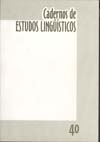Abstract
Pronominal agreement and grammatical agreement are distinguished. In particular, it is argued that pronominal agreement may involve the semantic interpretation of the formal gender feature of the pronoun independently from the interpretation of the gender feature of the antecedent. The vulnerability of lexicalsyntactic information concerning the gender of the antecedent is also considered. Two experiments are reported which explore the possibility of [+animate] nouns being gender invariable in Portuguese and information is provided regarding the natural gender (sex) of the gender invariable antecedent of the pronoun. The effect of grammatical gender/natural gender congruence upon the processing of pronominal forms is investigated. In the fist experiment, the sentences of the pair are contiguous and in the second one, the distance between antecedent and pronoun is enlarged. The results of Exp. 1 suggest that lexicalsyntactic information prevails though the processing of pronominal reference is facilitated when there is semantic information compatible with the semantic interpretation of the gender of the pronoun. The results of Exp 2 suggest that pronominal reference can be solved on a semantic basis when information concerning the grammatical gender of the linguistic antecedent is not available. The results are compatible with a model of sentence processing which predicts integrative processes at the end of the sentence. They also contribute to the creation of a discourse-processing model that expresses how cohesive relationships involving pronominal forms can be established.
References
ARIEL, M. (1994). Interpreting anaphoric expressions: A cognitive vs a pragmatic approach. Linguistics, 30: 3-42.
ARNOLD, J. E., EISENBAND, J. G., BROWN-SCHMIDT, S. & TRUESWELL, J. C. (2000). The rapid use of gender information: evidence of the time course of pronoun resolution from eyetracking. Cognition, 00, 1-14.
CACCIARI, C., CARREIRAS, M. & CIONINI, C.B. (1997). When words have two genders: Anaphor resolution for Italian functionally ambiguous words. Journal of Memory and Language, 37, 517-532.
CARREIRAS, M., GARNHAM, A. & OAKHILL, J. (1993). The use of superficial and meaning-based representations in interpreting pronouns. Evidence from Spanish. European Journal of Cognitive Psychology, 5, 1, 93 – 116.
CHOMSKY, N. (1995). The Minimalist Program. Cambridge, Mass: MIT Press.
COMRIE, B. (1999). Grammatical gender systems: A linguist’s assessment. Journal of Psycholinguistic Research, vol.28, nº 5, 457-466.
CORBETT, G. (1991). Gender. Cambridge. CUP.
CORRÊA, L.M.S. (1993). Restrições ao pronome livre na linearização do discurso. Revista PaLavra, nº 1, 75-95.
CORRÊA, L.M.S. (2000). Acessibilidade diferenciada e fatores estruturais na produção e na compreensão de formas pronominais. Revista Palavra, nº 6, 134-153.
CRAWLEY, R. A., STEVENSON, R. J. & KLEIMAN, D. (1990). The use of heuristic strategies in the interpretation of pronouns. Journal of Psycholinguistic Research, 19, 245–264.
DEUTSCH, A. & BENTIN, S. (2001). Syntactic and semantic factors in processing gender agreement in Hebrew: evidence from ERPs and eye movements. Journal of Memory and Language, 45, 200-224.
FRIEDERICI, (1995). The time course of syntactic activation during language processing: A model based on neuropsychological and neurophysiological data. Brain and Language, 50, 259-281.
FRIEDERICI, A. & JACOBSEN, T. (1999). Processing grammatical gender during language comprehension. Journal of Psycholinguistic Research, vol.28, no.5, 467-486.
FRIEDERICI, A., MECKLINGER, A., SPENCER, K. M., STEINHAUER, K. & DONCHIN, E. (2001). Syntactic parsing preferences and their on-line revisions: a spatio-temporal analysis of event-related brain potentials. Cognitive Brain Research,11, 2, 305-323.
GARNHAM, A., OAKHILL, J., EHRLICH, M.F. & CARREIRAS, M. (1995). Representation and Processes in the Interpretation of Pronouns: New Evidence from Spanish and French. Journal of Memory and Language, 34, 41-62.
GERNSBACHER, M. A. (1991). Comprehending conceptual anaphors. Language and Cognitive Processes, 6, 81– 105.
GORDON, P. C. & CHAN, D. (1995). Pronouns, passives and discourse coherence. Journal of Memory and Language, 34, 216–231.
GROSZ, B. J. & SIDNER, C. L. (1986). Attention, intentions, and the structure of discourse. Computational Linguistics, 12, 175–204.
GUNTER, T.C., FRIEDERICI, A.D. & SCHRIEFERS, H. (2000). Syntactic gender and semantic expectancy: ERPs reveal early autonomy and late interaction. Journal of Cognitive Neuroscience, 12, 556–568.
HAHNE, A. & FRIEDERICI, A. (2000). Differential task effects on semantic and syntactic processes as revealed by ERPs. Cognitive Brain Research ,13, 3, 339-356.
JARVELLA, R. J. & HERAMN, S. J. (1972). Clause structure of sentences and speech processing. Perception and Psychophysics, 11, 381-384.
LIU, S. R. A., CHIARELLO, C. & QUAN, N. (1999). Hemispheric sensitivity to grammatical cues: evidence for bilateral processing of number agreement in noun phrases. Brain and Language, 70, 483-503.
MCKOON, G., GREENE, S. B. & RATCLIFF, R. (1993). Discourse models, pronoun resolution, and the implicit causality of verbs. Journal of Experimental Psychology: Learning, Memory and Cognition, 19, 1040 – 1052.
PALLIER, C., DUPOUX, E. & JEANNIN, X. (1999). EXPE6 – Reference Manual. Laboratoire de Sciences Cognitives et Psycholinguistique, EHHSS, CNRS.
PEARLMUTTER, N. J., GARNSEY, S. M. & BOCK, K. (1999). Agreement processes in sentence comprehension. Journal of Memory and Language, 41, 427-456.
SCHRIEFERS, H. & JESCHENIAK, J.D. (1999). Representation and processing of grammatical gender in language production: A review. Journal of Psycholinguistic Research, vol.28, no. 6, 575-600.
TOWNSEND, D. J. & BEVER, T.G. (1978). Interclause Relations and Clausal Processing. Journal of Verbal Learning and Verbal Behavior, 17, 509-521.
VAN BERKUN, J.J.A., BROWN, C. & HAGOORT, P. (1999). When does gender constrain parsing? Evidence from ERP. Journal of Psycholinguistic Research, vol.28, no.5, 555-571.
The journal CADERNOS DE ESTUDOS LINGUÍSTICOS is granted all the copyright related to the published works. The originals will not be returned. By virtue of being part of this public access journal, the articles are free to use, with their own attributions, in educational and non-commercial applications

